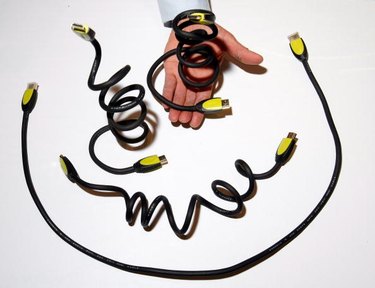
High-definition multimedia interface (HDMI) cables and coaxial cables are equally important in a home theater system. The picture quality differences between the two cables have less to do with the cables themselves than the manner in which the connected equipment sends signals over those wires. However, HDMI and coaxial cables are deployed with modern gear in ways that must be considered prior to wiring.
HDMI
Video of the Day
HDMI is the favorite among hardware manufacturers and content producers. HDMI facilitates 1080p video resolution along with uncompressed audio. All of this is sent over a cable that resembles a large USB cable, used with computers. The best picture quality between HDMI and coaxial cables goes to HDMI.
Video of the Day
Coaxial Cables
Coaxial cables use an "F" connector. This threaded termination has been used on televisions, VCRs and gaming systems for decades. The bandwidth of coaxial cable makes it ideal for sending digital data from cable and satellite services to the decoder boxes inside the house. However, when a coaxial cable is used as an interconnect between the hardware and television, it forces audio and video over the single copper center conductor on the cable. This limits resolution to slightly over 300 lines, and audio to stereo.
HDMI Topology
The reason why the picture quality of HDMI exceeds that of coaxial cable is the manner in which the cable is made, in conjunction with how the equipment is designed to handle data. Nine internal wires carry the picture and sound data along the TMDS, or Transition Minimized Differential Signaling channel. Like all digital connections, this requires encoding and decoding at each end of the hardware chain.
Coaxial is Still Useful
Coaxial cable uses one 18-gauge center conductor to send its signals at a high level. Various balun adapters exist to transmit HDMI resolutions over dual coaxial cables. This is useful to leverage an existing coaxial installation, employing short HDMI cables at the sending and receiving ends. Also, three coaxial cables are routinely used in custom installations for creating component video interconnects capable of 1080p HD video.